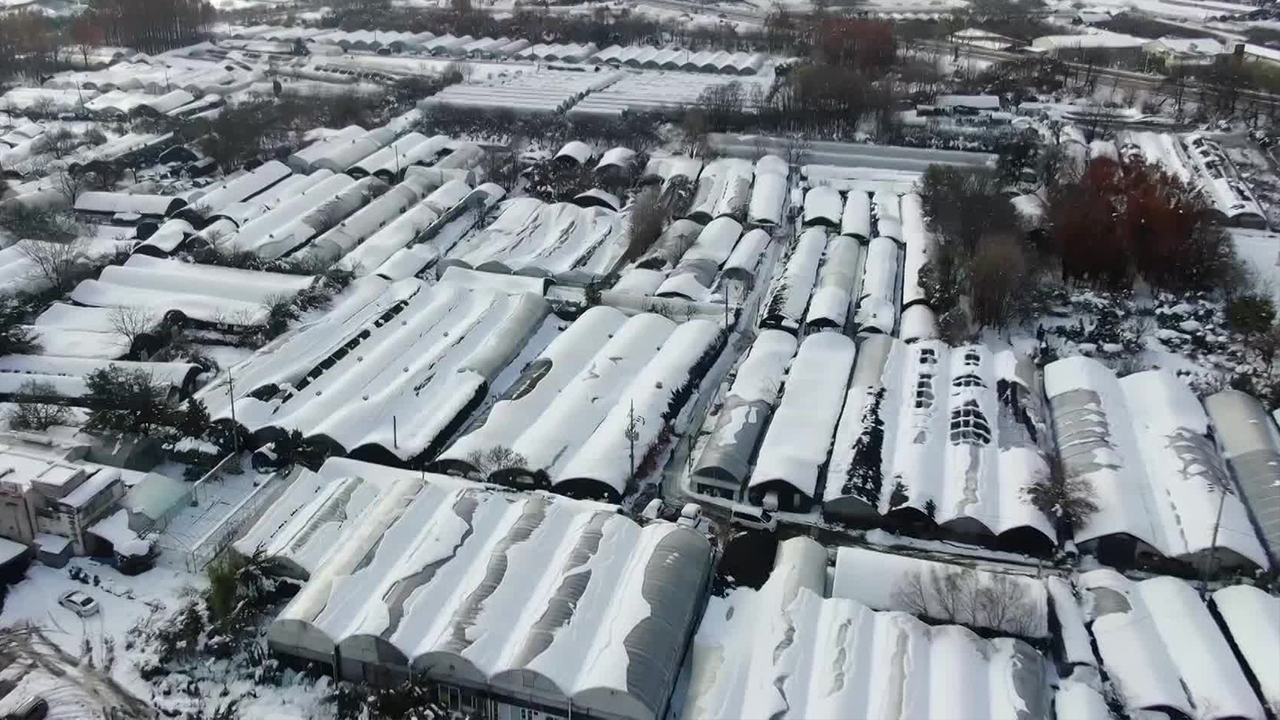Damages worsened by high moisture content of ‘wet snow’
입력 2024.11.28 (23:53)
읽어주기 기능은 크롬기반의
브라우저에서만 사용하실 수 있습니다.
[Anchor]
This heavy snowfall has particularly caused a lot of damage to facilities and structures.
The snow was high in moisture content, making it two to three times heavier than usual snow.
What caused this wet snow? Meteorologist Kim Min-kyung has analyzed it.
[Report]
Many areas of the snow-covered greenhouses have collapsed.
The metal supports that held up the greenhouses have bent like taffy.
The roof of an underground parking entrance has also crumpled as if it had been hit by a bomb.
Trees along the streets have fallen under the weight of the snow.
While the amount of snow that fell was significant, this snow was particularly heavy.
This is because it is 'wet snow' with droplets thickly clinging to the edges of the snowflakes.
Wet snow is heavier, weighing 2 to 3 times more than 'dry snow' due to its larger snowflakes and higher moisture content.
For a greenhouse that is 5 meters wide and 20 meters long, just 10 cm of wet snow can weigh up to 3 tons, and if it accumulates more than 50 cm, it can weigh about 15 tons.
The occurrence of wet snow is influenced by the warmer sea temperatures around the country, which are about 2 degrees higher than average.
As snow clouds developed over the Yellow Sea, they received a large amount of water vapor on their way to our country.
[Kim Byeong-kwon/Meteorological Administration Forecast Analyst: "When it snows and the temperature is below zero, there is a high possibility of light 'dry snow' falling, but if the temperature is around 0 degrees, the moisture sticks to the snowflakes, resulting in heavy 'wet snow'."]
To prevent collapse damage from wet snow, it is important to frequently clear the snow before it accumulates and to reinforce the supports of weak structures in advance.
This is KBS News, Kim Min-kyung.
This heavy snowfall has particularly caused a lot of damage to facilities and structures.
The snow was high in moisture content, making it two to three times heavier than usual snow.
What caused this wet snow? Meteorologist Kim Min-kyung has analyzed it.
[Report]
Many areas of the snow-covered greenhouses have collapsed.
The metal supports that held up the greenhouses have bent like taffy.
The roof of an underground parking entrance has also crumpled as if it had been hit by a bomb.
Trees along the streets have fallen under the weight of the snow.
While the amount of snow that fell was significant, this snow was particularly heavy.
This is because it is 'wet snow' with droplets thickly clinging to the edges of the snowflakes.
Wet snow is heavier, weighing 2 to 3 times more than 'dry snow' due to its larger snowflakes and higher moisture content.
For a greenhouse that is 5 meters wide and 20 meters long, just 10 cm of wet snow can weigh up to 3 tons, and if it accumulates more than 50 cm, it can weigh about 15 tons.
The occurrence of wet snow is influenced by the warmer sea temperatures around the country, which are about 2 degrees higher than average.
As snow clouds developed over the Yellow Sea, they received a large amount of water vapor on their way to our country.
[Kim Byeong-kwon/Meteorological Administration Forecast Analyst: "When it snows and the temperature is below zero, there is a high possibility of light 'dry snow' falling, but if the temperature is around 0 degrees, the moisture sticks to the snowflakes, resulting in heavy 'wet snow'."]
To prevent collapse damage from wet snow, it is important to frequently clear the snow before it accumulates and to reinforce the supports of weak structures in advance.
This is KBS News, Kim Min-kyung.
■ 제보하기
▷ 카카오톡 : 'KBS제보' 검색, 채널 추가
▷ 전화 : 02-781-1234, 4444
▷ 이메일 : kbs1234@kbs.co.kr
▷ 유튜브, 네이버, 카카오에서도 KBS뉴스를 구독해주세요!
- Damages worsened by high moisture content of ‘wet snow’
-
- 입력 2024-11-28 23:53:18

[Anchor]
This heavy snowfall has particularly caused a lot of damage to facilities and structures.
The snow was high in moisture content, making it two to three times heavier than usual snow.
What caused this wet snow? Meteorologist Kim Min-kyung has analyzed it.
[Report]
Many areas of the snow-covered greenhouses have collapsed.
The metal supports that held up the greenhouses have bent like taffy.
The roof of an underground parking entrance has also crumpled as if it had been hit by a bomb.
Trees along the streets have fallen under the weight of the snow.
While the amount of snow that fell was significant, this snow was particularly heavy.
This is because it is 'wet snow' with droplets thickly clinging to the edges of the snowflakes.
Wet snow is heavier, weighing 2 to 3 times more than 'dry snow' due to its larger snowflakes and higher moisture content.
For a greenhouse that is 5 meters wide and 20 meters long, just 10 cm of wet snow can weigh up to 3 tons, and if it accumulates more than 50 cm, it can weigh about 15 tons.
The occurrence of wet snow is influenced by the warmer sea temperatures around the country, which are about 2 degrees higher than average.
As snow clouds developed over the Yellow Sea, they received a large amount of water vapor on their way to our country.
[Kim Byeong-kwon/Meteorological Administration Forecast Analyst: "When it snows and the temperature is below zero, there is a high possibility of light 'dry snow' falling, but if the temperature is around 0 degrees, the moisture sticks to the snowflakes, resulting in heavy 'wet snow'."]
To prevent collapse damage from wet snow, it is important to frequently clear the snow before it accumulates and to reinforce the supports of weak structures in advance.
This is KBS News, Kim Min-kyung.
This heavy snowfall has particularly caused a lot of damage to facilities and structures.
The snow was high in moisture content, making it two to three times heavier than usual snow.
What caused this wet snow? Meteorologist Kim Min-kyung has analyzed it.
[Report]
Many areas of the snow-covered greenhouses have collapsed.
The metal supports that held up the greenhouses have bent like taffy.
The roof of an underground parking entrance has also crumpled as if it had been hit by a bomb.
Trees along the streets have fallen under the weight of the snow.
While the amount of snow that fell was significant, this snow was particularly heavy.
This is because it is 'wet snow' with droplets thickly clinging to the edges of the snowflakes.
Wet snow is heavier, weighing 2 to 3 times more than 'dry snow' due to its larger snowflakes and higher moisture content.
For a greenhouse that is 5 meters wide and 20 meters long, just 10 cm of wet snow can weigh up to 3 tons, and if it accumulates more than 50 cm, it can weigh about 15 tons.
The occurrence of wet snow is influenced by the warmer sea temperatures around the country, which are about 2 degrees higher than average.
As snow clouds developed over the Yellow Sea, they received a large amount of water vapor on their way to our country.
[Kim Byeong-kwon/Meteorological Administration Forecast Analyst: "When it snows and the temperature is below zero, there is a high possibility of light 'dry snow' falling, but if the temperature is around 0 degrees, the moisture sticks to the snowflakes, resulting in heavy 'wet snow'."]
To prevent collapse damage from wet snow, it is important to frequently clear the snow before it accumulates and to reinforce the supports of weak structures in advance.
This is KBS News, Kim Min-kyung.
-
-

김민경 기자 minkyung@kbs.co.kr
김민경 기자의 기사 모음
-
이 기사가 좋으셨다면
-
좋아요
0
-
응원해요
0
-
후속 원해요
0















이 기사에 대한 의견을 남겨주세요.